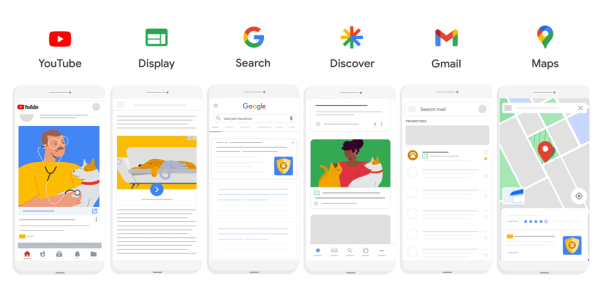So by now you’ve probably heard about the introduction of Performance Max & the sunsetting on Smart Shopping. Some may be worried about what this means for their campaigns, as we know Google’s changes aren’t always the best in the eyes of an advertiser. However, I’m here to run through what Performance Max is, how it works & how you can get the best out of it.
What is Performance Max?
Don’t be put off by the name – this isn’t a completely new product. It still acts in the same way as Smart Shopping but takes machine learning and visibility to the next level, incorporating more channels than ever before. This means that advertisers can now reach more customers from just one campaign, letting Google’s machine learning & automation optimise bids & placements that are based around your budgets, goals & conversions. Performance Max is essentially Smart Shopping Plus.
How does it work?
Performance Max is a goal based campaign type that allows users to access a wider range of the Google Network including:
- • YouTube
- • Display
- • Search
- • Discover
- • Gmail
- • Maps
Building on the “Standard Shopping” & “Display Remarketing” combination of Smart Shopping, Performance Max also brings new opportunities by adding “Dynamic Search Ads” to the mix. This complements existing Search Keywords within the account but acts as a catch-all to ensure that advertisers are not missing out on any sales.
As I said before, this is a goal based campaign & in honour of its name, the main focus of these campaigns is to drive performance based on the specific conversion goals that you set.
How do I set a Performance Max campaign up?
Google automates the targeting of Performance Max campaigns based on the information that you provide. Primarily, this is the budget & the campaign goal which gives the constraints to which the campaign needs to adhere to. Performance Max uses asset groups which are a collection of creatives centred on a theme or related to a target audience. Advertisers also need to provide the following creative assets which consist of:
- • Final URL
- • Up to 15 Images
- • Up to 5 Logos
- • Up to 5 Videos (Google has autocreated videos if you don’t provide any but honestly, if you have the resource, it is definitely worth creating these yourself as the auto-created ones aren’t the best)
- • Up to 5 Headlines
- • Up to 5 Long Headlines
- • Up to 5 Descriptions
- • Call To Action
- • Business Name
However, new updates from Google’s Ads Liaison, Ginny Marvin, confirmed that if you connect your Google Merchant Feed but don’t provide any other assets, the campaign will only serve Shopping Ads. So if this is your primary focus & you don’t want to go back to Standard Shopping this could be the answer.
You can also add audience signals to hit the ground running & feed data into the algorithm – this will also be used to continuously inform the algorithms throughout the lifecycle of the campaign.
Another important upgrade to Performance Max builds on the “New Customer Acquisition” feature of Smart Shopping where you could value new customers higher than returning. In PMax, you can now bid more for new customers or bid only for new customers. This could be a really interesting growth tool for businesses to expand their current customer base more specifically than ever before.
Performance Max also builds on the “Insights” tab of Smart Shopping, taking this further to highlight search themes that are driving conversions – this will give better insights into the trends & patterns within the market. Alongside this, it will also showcase what types of audiences are engaging with the different assets that the ads are showing. This will help you to understand how users are interacting with the ads and you can then use this information to improve & tailor your ads more effectively.
Performance Max continues the drawbacks of Smart Shopping too, with a lack of visibility over channel-specific performance & lack of manual optimisation; especially around the addition of negative keywords & placements. However, Google representatives have explained that this lack of data is to ensure that advertisers are allowing the algorithms to do their job properly. Giving these insights may enable human bias to pull away from certain areas within the campaign, be that channels or placements, but users should be reassured that the campaign’s sole focus is on performance. Basically, the algorithms will be taking into account any areas that aren’t delivering the required results & optimising towards the ones that do. Makes sense when you think of it like that huh?
So what do I do now?
Smart Shopping is being sunsetted in September 2022, therefore you have a bit of time to experiment & see what works for you. My guess would be to wait until the one-click migration tool is live in May. This will allow you to automatically migrate your Smart Shopping campaigns into Performance Max, meaning that there is no potential downtime of the campaigns. Doing it this way also means that Performance Max will be able to use all the historical data from the Smart Shopping campaign resulting in a much shorter learning period. This seems the safest option in both the transition & the speed of performance off the back of the migration. You can of course start testing now, however, this means that you will need to set the campaigns up from scratch which could be a lot more time consuming & leaves more room for human error.











